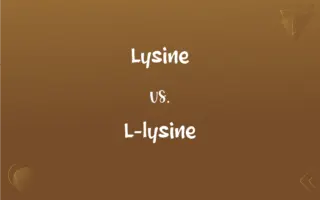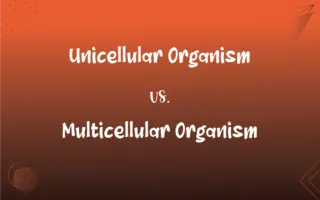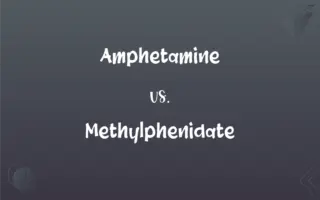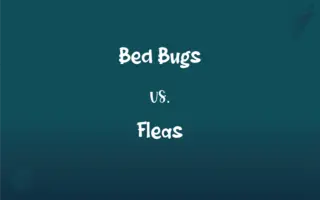Bryophytes vs. Pteridophytes: What's the Difference?
Edited by Aimie Carlson || By Harlon Moss || Updated on October 16, 2023
Bryophytes are non-vascular, simple plants like mosses, while pteridophytes are vascular, more complex plants like ferns.
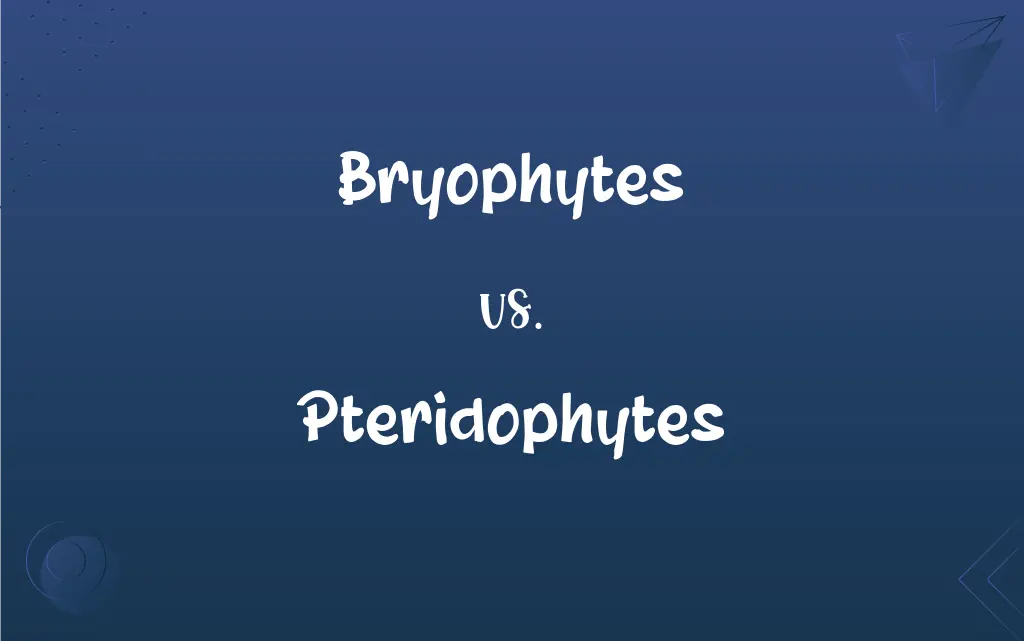
Key Differences
Bryophytes and pteridophytes are both non-flowering plants, but they occupy different evolutionary positions and exhibit varied structural and reproductive characteristics. Bryophytes, often referred to as mosses and liverworts, are among the simplest of land plants. They lack true vascular tissues and do not produce seeds. Pteridophytes, including ferns and horsetails, are more complex, possessing vascular tissues but, like bryophytes, do not produce seeds or flowers.
From a habitat perspective, bryophytes and pteridophytes often thrive in moist environments. Bryophytes are typically found in damp, shaded woods, wetlands, or other humid places, as they require a wet environment for reproduction. Their lack of vascular tissues means they cannot transport water efficiently and remain low to the ground. Pteridophytes, with their vascular systems, can grow taller and are commonly found in forests, meadows, and swamps. Despite their vascular advantage, pteridophytes also favor moisture-rich environments, especially for their reproductive processes.
Reproduction in bryophytes and pteridophytes differs significantly due to their distinct life cycles. Bryophytes have a dominant gametophyte stage, wherein the visible moss or liverwort plant we observe is the gametophyte that produces gametes. These gametes fuse in the presence of water to form a sporophyte, which is often a stalk rising from the gametophyte. Pteridophytes, on the other hand, have a dominant sporophyte stage. The large fern plant we commonly recognize is the sporophyte. It produces spores, which grow into tiny, often overlooked gametophytes that produce gametes.
In terms of evolutionary history, both bryophytes and pteridophytes represent critical steps in the adaptation of plants to terrestrial environments. Bryophytes are believed to be among the earliest land plants, marking the initial transition from aquatic to terrestrial habitats. Their simplicity and reliance on water for reproduction reflect their ancestral aquatic ties. Pteridophytes, having evolved after bryophytes, represent an intermediate stage. Their vascular systems indicate advancement, but their seedless nature places them between bryophytes and the more evolved seed plants.
In summation, while bryophytes and pteridophytes share some similarities as non-flowering, seedless plants, they are fundamentally different in structure, reproduction, and evolutionary significance. Bryophytes, with their simple structure and heavy reliance on water, represent an initial step in land colonization by plants. Pteridophytes, with vascular systems but without seeds, showcase an intermediate evolutionary stage, bridging the gap between the simpler bryophytes and the more advanced seed plants.
ADVERTISEMENT
Comparison Chart
Basic Definition
Non-vascular, simple plants
Vascular, more complex plants
Examples
Mosses, liverworts, hornworts
Ferns, horsetails, clubmosses
Vascular System
Absent
Present
Dominant Life Stage
Gametophyte
Sporophyte
Habitat
Mostly moist environments
Varied, including drier environments
ADVERTISEMENT
Bryophytes and Pteridophytes Definitions
Bryophytes
Plants that lack true roots, stems, and leaves.
Despite their simplicity, bryophytes play vital roles in ecosystems.
Pteridophytes
Seedless plants with true roots and leaves.
The height some pteridophytes achieve is due to their well-developed vascular system.
Bryophytes
Plants with a dominant gametophyte stage.
The sporophyte of bryophytes is dependent on the gametophyte for nutrition.
Pteridophytes
More complex than bryophytes in structure.
The presence of vascular tissues sets pteridophytes apart from bryophytes.
Bryophytes
Commonly found in damp habitats.
Bryophytes thrive in environments where there's consistent moisture.
Pteridophytes
Plants with a dominant sporophyte stage.
In pteridophytes, the gametophyte is generally much smaller than the sporophyte.
Bryophytes
Non-vascular land plants.
Bryophytes often carpet forest floors, providing a lush green layer.
Pteridophytes
Vascular plants that reproduce via spores.
Ferns, a type of pteridophytes, are commonly seen in gardens and forests.
Bryophytes
Seedless plants that reproduce via spores.
Unlike flowering plants, bryophytes don't produce flowers or seeds.
Pteridophytes
Includes ferns, horsetails, and clubmosses.
Pteridophytes are often admired for their ornamental value in gardens.
Bryophytes
Any of numerous photosynthetic, chiefly terrestrial, nonvascular plants that reproduce by spores, including the mosses, liverworts, and hornworts. These three groups together formerly made up the division Bryophyta, which is now restricted to the mosses alone.
Pteridophytes
Any of numerous vascular plants that reproduce by means of spores rather than seeds, including the ferns and related plants such as horsetails, and sometimes the club mosses.
Bryophytes
Plural of bryophyte
Pteridophytes
Plural of pteridophyte
FAQs
Why are bryophytes important?
They help in soil formation, prevent erosion, and play roles in nutrient cycling and water retention.
Do bryophytes have roots?
No, they have rhizoids instead, which are small, root-like structures for anchorage, not water absorption.
How do bryophytes reproduce?
They reproduce both sexually (via spores) and asexually (via fragmentation).
What are bryophytes?
Bryophytes are small, non-vascular land plants, such as mosses, liverworts, and hornworts.
Where are bryophytes commonly found?
They're typically found in damp, humid environments.
What's the importance of pteridophytes?
They help prevent erosion, promote biodiversity, and have roles in human culture and medicine.
Where can pteridophytes be found?
They are commonly found in damp, shady environments.
Are bryophytes vascular plants?
No, bryophytes are non-vascular; they lack specialized tissues for water and nutrient transport.
Do bryophytes need water for reproduction?
Yes, they require water for the movement of sperm to the egg during sexual reproduction.
Do pteridophytes have flowers?
No, they don't produce flowers.
Can pteridophytes grow in water?
Some can grow in water or in very damp conditions, but most prefer moist soil.
Do pteridophytes have true roots?
Yes, they have true roots, stems, and leaves.
What are pteridophytes?
Pteridophytes are a group of vascular plants that reproduce via spores, including ferns, horsetails, and clubmosses.
Are bryophytes evergreen?
Some are evergreen, but this can vary greatly depending on the species and environment.
Do pteridophytes produce seeds?
No, they reproduce through spores, not seeds.
Are pteridophytes evergreen?
It depends on the species; some are evergreen while others are not.
Are bryophytes photosynthetic?
Yes, they contain chlorophyll and perform photosynthesis.
Are pteridophytes vascular?
Yes, they have specialized tissues (xylem and phloem) for water and nutrient transport.
How do pteridophytes reproduce?
They reproduce sexually via spores released from sporangia.
Can bryophytes grow on rocks?
Yes, they can grow on rocks, as they don't rely on roots for nutrient uptake.
About Author
Written by
Harlon MossHarlon is a seasoned quality moderator and accomplished content writer for Difference Wiki. An alumnus of the prestigious University of California, he earned his degree in Computer Science. Leveraging his academic background, Harlon brings a meticulous and informed perspective to his work, ensuring content accuracy and excellence.
Edited by
Aimie CarlsonAimie Carlson, holding a master's degree in English literature, is a fervent English language enthusiast. She lends her writing talents to Difference Wiki, a prominent website that specializes in comparisons, offering readers insightful analyses that both captivate and inform.























